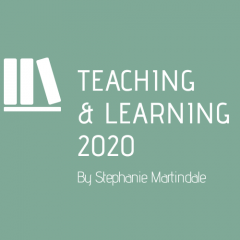I’m finding this experience of ‘blogging’ quite interesting. Documenting my thoughts, feelings, ideas and opinions is very new to me and the fact that is it open for others to read brings me an unreasonable level of anxiety. But I do realise that that’s all part of the process, particularly as one of my personal development goals for 2020 is to push myself outside of my comfort zone and challenge myself. So onwards we continue with blog life…
Unfortunately, I missed my first Teaching & Learning tutor group session on the 20th January due to unforeseen circumstances. This meant that I was unable to present the presentation I had prepared about pedagogy to my peers. I did, however learn some valuable lessons on some pedagogic practices designed to enhance engagement, which I will outline below.
As an undergrad student (6+ years ago), I always struggled with staying focussed and engaged with delivered teaching content during class. I often found myself daydreaming, scrolling on my phone and sometimes (regrettably in hindsight) even putting my head down on the desk for a mid-lesson nap. This led to poor-time management and disorganisation as I would usually end up spending additional hours at home trying to catch up on what I had missed in class due to my dwindling attention span.
So when I came across the journal paper entitled ‘Exploring student definitions of engagement: A reflexive approach to designing learning activities’ (Huggard, 2010), I was immediately drawn in to read more. The article explores the definitions of student ‘engagement’ from the perspective of the students themselves and seeks to identify various teaching methods to improve student learner engagement which align with students expectations.
This is in contrast to the institutionalised and behavioural-based definitions of engagement that have formed as a result of the rise in universal format of higher education. Mcfarlane (2015) identifies this as students ‘demonstrating more visibly that they are learning through participation in class’ and ‘sharing their ideas in public discussions’
To challenge this, the report goes on to identify two pedagogies of engagement (which were designed based on student definitions of engagement) which were of most interest to me as a teaching practitioner:
1. Problem Based Learning – learning that results from the process of working towards understanding or resolution of a problem (Smith et al., 2005)
2. Experiential Based Learning – learning encouraged through experience (Benecke and Bezuidenhout, 2011)
Problem Based Learning (PBL) is a student-led learning method through which students apply taught knowledge to real brand issues and build competencies for their creative industries. Case studies are considered to be an effective method of PBL which is effective in achieving greater engagement with unit learning outcomes, retention of material and cooperative interaction (Baturay and Bay, 2010) and (Meyers and Jones, 1993).

In contrast, Experiential Based Learning (EBL), utilises active student participation to encourage learning through experience via practical, hands-on projects. This could include community involvement projects for example (Benecke and Bezuidenhout, 2011). Kolb (1984) identifies conflict, differences, and disagreement as key notions to drive the learning process in EBL practice.

Given that both teaching methods have been developed reflexively in response to the student-definitions of engagement, one may assume that an increase in engagement could be measured in teaching sessions if PBL and EBL pedagogies are applied. Although the report did not assess this, I would be keen to apply particularly PBL tasks such as case-studies in my own teaching practice to very teaching content and enhance student engagement.
Furthermore, the report raised some questions for me:
- What variable factors can be identified that increase engagement?
- The report did not approach student engagement from a holistic perspective, so I would be keen to understand what sociological, behavioural and/or psychological factors can be of influence
- How can we integrate technology and specifically the use of mobile phones in to lesson plans to improve engagement?
- As technology has now become an instrumental tool for both teachers and learners, how can this be incorporated effectively to enhance rather than hinder engagement? This is of particular interest to me due to my mobile device, as mentioned earlier, being a hindrance to my learning as a distraction as an undergrad student.
- Benecke, R.D. and Bezuidenhout, R.M. (2011) ‘Experiential learning in public relations education in South Africa’, Journal of Communication Management, 15(1), pp. 55–69.
- Gibbs, G. (2014) ‘Student engagement, the latest buzzword’, Times Higher Education, 1 May. Available at: https://www.timeshighereducation.co.uk/news/student-engagement-the-latest-buzzword/2012947.article (Accessed: 2 April 2015)
- Huggard, E. (2016) ‘Exploring student definitions of engagement: A reflexive approach to designing learning activities’, Sparks Journal, 1 (1), pp. 5 – 18
- Kolb, D.A. (1984) Experiential learning: experience as the source of learning and development. Englewood Cliffs, NJ: Prentice-Hall.
- Macfarlane, B. (2015) Student performativity in higher education: converting learning as a private space into a public performance, Higher Education Research & Development, 32 (2), pp. 338–350.
- Meyers, C. and Jones, T.B. (1993) Promoting active learning: strategies for the college classroom. San Francisco: Jossey-Bass.
- Smith, K.A., Sheppard, S.D., Johnson, D.W. and Johnson, R.T. (2005) ‘Pedagogies of engagement: classroom-based practices’, Journal of Engineering Education, 94(1), pp. 87–101.
